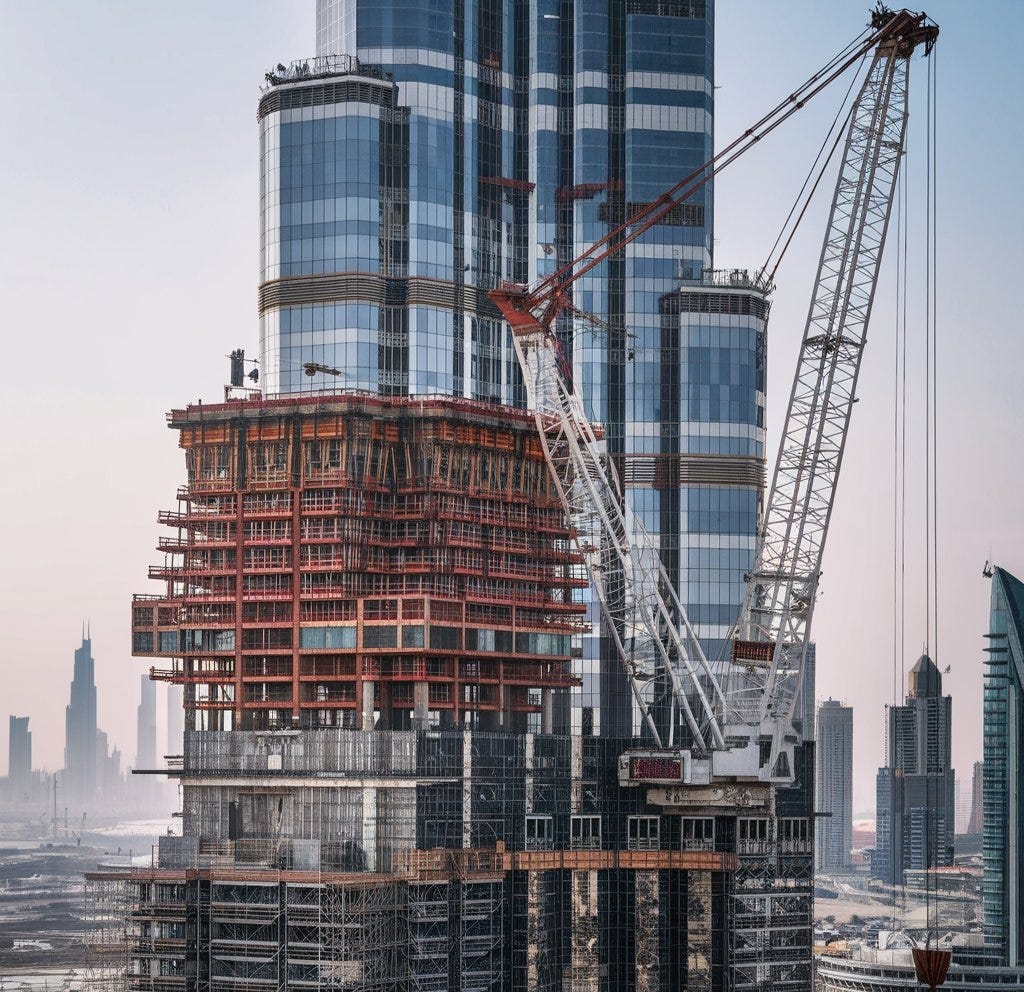Burj Khalifa Construction Timeline, Key Players, and Statistics
Główne pojęcia
The Burj Khalifa, completed in 2010, was a complex, multi-year construction project involving numerous international companies and experts.
Streszczenie
This content provides a brief overview of the Burj Khalifa's construction. It is structured as an informative article rather than a research paper.
Construction Timeline and Key Players
- Construction began in January 2004 and lasted nearly five years and nine months, with completion in October 2009.
- The official launch date was January 4, 2010.
- Arabtec Holding, Samsung C&T, and Besix Group formed the construction consortium.
- Notable companies involved include Emaar Properties PJSC, Skidmore, Owings & Merrill (SOM), Hyder Consulting, RWDI, and Langan International.
Key Personnel
- Adrian Smith of SOM served as the lead architect.
Technical Aspects
- The project involved complex wind engineering, as evidenced by the Liquid Dynamics in BMT Wind Tunnel Test.
Dostosuj podsumowanie
Przepisz z AI
Generuj cytaty
Przetłumacz źródło
Na inny język
Generuj mapę myśli
z treści źródłowej
Odwiedź źródło
medium.com
BURJ KHALIFA CONSTRUCTION
Statystyki
Total construction time: almost 5 years and 9 months.
Cytaty
Kluczowe wnioski z
by Waqas Muneer o medium.com 10-20-2024
https://medium.com/@waqasmuneer251/burj-khalifa-construction-71d73f3070ee
Głębsze pytania
What were some of the specific challenges faced during the construction of the Burj Khalifa, given its unprecedented scale and innovative design?
The Burj Khalifa's unprecedented scale and innovative design presented a myriad of challenges during its construction. Here are some of the key hurdles faced:
Wind Loads: Located in a desert environment prone to high winds, the Burj Khalifa's extreme height (over 828 meters) made it susceptible to significant wind forces. To mitigate this, the building's unique Y-shaped footprint was strategically designed to reduce wind loads, and rigorous wind tunnel testing was conducted by RWDI to optimize its aerodynamic profile.
Concrete Pumping: Pumping concrete to such extreme heights was a major logistical challenge. A special high-density, low-exotherm concrete mix was developed, capable of withstanding enormous pressures. Furthermore, powerful pumps were employed, and concrete pours were often scheduled for cooler nighttime hours to prevent premature setting.
Vertical Transportation: Moving materials and workers efficiently within the towering structure was crucial. A complex system of high-speed service elevators was implemented, capable of reaching incredible speeds.
Coordination and Logistics: The sheer scale of the project, involving a consortium of international companies and thousands of workers, demanded meticulous coordination and logistical planning. Effective communication and collaboration between Emaar Properties PJSC (the project manager), SOM Architects, Hyder Consulting (engineers), and the various subcontractors were paramount to the project's success.
Extreme Temperatures: The scorching desert heat posed significant challenges for workers and materials. Special heat-resistant materials were used, and work schedules were adjusted to minimize exposure to the harshest temperatures.
Overcoming these challenges required innovative engineering solutions, cutting-edge construction techniques, and the collaborative efforts of a global team of experts.
Considering the environmental impact of such massive construction projects, was the Burj Khalifa designed with sustainability in mind?
While the Burj Khalifa's construction undoubtedly had a significant environmental footprint, some sustainable design elements were incorporated:
Energy Efficiency: The building's exterior cladding features a high-performance reflective glazing system, reducing solar heat gain and minimizing the need for air conditioning.
Water Conservation: A condensate collection system captures water vapor from the building's cooling system, providing a significant source of irrigation water for the surrounding landscape.
Recycled Materials: A portion of the construction materials used in the Burj Khalifa, such as reinforced steel, were sourced from recycled content.
However, it's important to acknowledge that the sheer scale of the project inherently carries a substantial environmental impact in terms of resource consumption and carbon emissions. The Burj Khalifa's sustainability features, while commendable, are unlikely to fully offset the environmental costs associated with its construction and operation.
How has the Burj Khalifa impacted tourism in Dubai and the perception of the city globally?
The Burj Khalifa has had a profound impact on Dubai's tourism industry and global image:
Iconic Landmark: The tower has become synonymous with Dubai, instantly recognizable worldwide and serving as a powerful symbol of the city's ambition and architectural prowess.
Tourist Magnet: Millions of tourists flock to Dubai each year to witness the Burj Khalifa's grandeur firsthand. The observation deck, "At the Top, Burj Khalifa," offers breathtaking panoramic views and is one of the city's most popular attractions.
Economic Boost: The Burj Khalifa's construction and ongoing operation have generated significant economic activity for Dubai, creating jobs in tourism, hospitality, and related sectors.
Global Recognition: The tower has catapulted Dubai onto the world stage, enhancing its reputation as a global hub for tourism, innovation, and luxury.
Urban Development Catalyst: The Burj Khalifa's development has spurred further urban development in Downtown Dubai, transforming the area into a vibrant hub for entertainment, dining, and upscale living.
In conclusion, the Burj Khalifa has had a transformative impact on Dubai, solidifying its status as a global tourist destination and a symbol of architectural achievement.
0
